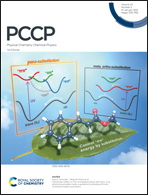Exciton diffusion in solid solutions of luminescent lanthanide β-diketonates†
Abstract
In this article, a series of luminescent lanthanide β-diketonate solid solutions, with the formula of TBAEuxM1−x(TTA)4 (TBA = tetrabutylammonium; M = La or Gd; TTA = 2-thenoyltrifluoroacetonate), are synthesized by co-precipitation. In the solid solutions, the emission efficiency of Eu3+ is significantly increased with the presence of non-luminescent chelates TBALa(TTA)4 and TBAGd(TTA)4. Low temperature luminescence spectroscopy studies indicate that the TTA− ligands in these non-luminescent chelates do emit phosphorescence with long lifetime. However, the ligand phosphorescence is strongly quenched in solid solutions with the luminescent chelate TBAEu(TTA)4, providing strong evidence for intermolecular energy transfer through the triplet excited states of the ligands. A quantitative analysis of Eu3+ emission enhancement and TTA− phosphorescence quenching reveals that each Eu3+ center may receive excitation energy from about 30 TTA− ligands, suggesting that the excitation energy has become exciton-like in the solid solutions. Based on the crystallography analysis of TBALn(TTA)4, it is discovered that TTA− ligands in neighboring Ln(TTA)4− units may form π–π stacks with intermolecular distance ≤3.5 Å, thus enabling efficient triplet exciton diffusion via exchange interaction.



 Please wait while we load your content...
Please wait while we load your content...
